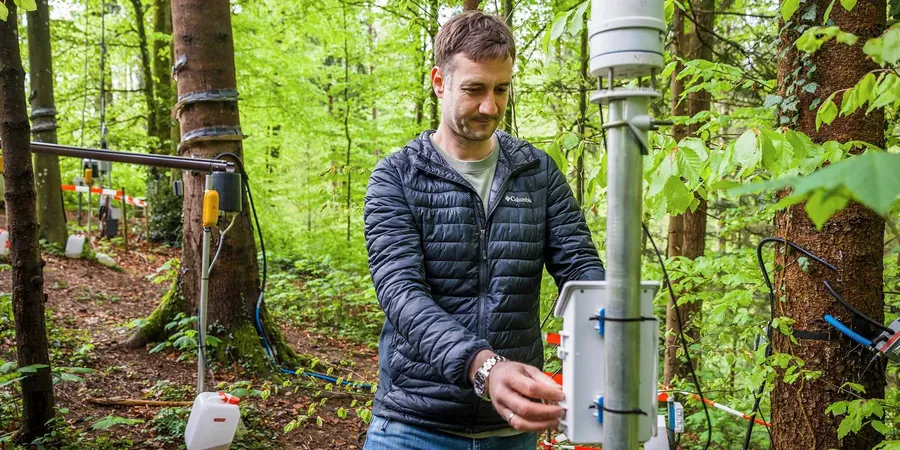
Unlocking Secrets of Old Water: How Forest Research is Changing Hydrology
2025-05-26
Author: Mei
Discovering the 'Old Water Paradox' in Nature
On a cool, damp Thursday morning, researcher Marius Floriancic races along a narrow path deep into the forest, where an intriguing experiment on hydrology is unfolding. Surrounded by towering beeches and spruces, the clearing is buzzing not just with wildlife, but with cutting-edge technology—the result of five years of dedicated research.
Floriancic, a Senior Research Assistant from ETH Institute of Environmental Engineering, is thrilled to share this unique research facility, nicknamed the 'Waldlabor.' Located just five minutes from campus, it allows students of all levels to dive into hands-on learning in a way that's rare worldwide.
Unlocking Old Water Secrets
At the core of their study are innovative 'suction cups' buried in the soil, designed to extract water from various depths—10, 20, 40, and 80 centimeters. This water is analyzed for stable isotopes, revealing its age and origins.
The findings support the 'old water paradox' theory: soil samples largely consist of water that has been stored for months or even years, with newer precipitation barely making a mark. Measurements from April 2020 to April 2023 reveal that even at a shallow soil depth, only a third of the water is younger than three weeks!
Revolutionizing Water Management
Moreover, the research indicates that even after heavy storms, much of the water in streams like Holderbach is often older than one month, underscoring the critical role of stored soil water in managing runoff.
These insights can revolutionize flood management strategies and reveal surprising truths about how trees utilize water. While older water fills the soil, newer water quickly penetrates deeper, impacting groundwater levels.
The Importance of Seasonal Water Dynamics
Floriancic showcases a creative water-collecting system attached to tree trunks, revealing that winter is the season when forests recharge their water supply most effectively. Despite summer rains making up the bulk of annual precipitation, the trees are often left longing for moisture during hot months.
Beneath the Forest Floor: A Hidden World
The litter layer, often overlooked, plays a significant role by cooling the forest microclimate while limiting water flow to the soil. Preliminary results indicate it retains approximately 18% of rainfall, a far cry from the previous estimation of only 3-4%.
Measuring Water Movement with Precision
To grasp how trees absorb and transport water, Floriancic's team has installed sap flow sensors and even a rare 'Scholander pressure bomb' to gauge leaf water potential. These innovative tools provide insights into how drought affects different tree species, with beeches and spruces reacting distinctively to water stress.
The Future of Forest Hydrology
As the climate crisis looms, foresters often ask which species may endure best. While research is still unfolding, Floriancic has gleaned vital insights: higher soil organic matter enhances water storage, suggesting that promoting biodiversity—along with maintaining deadwood in forests—could bolster water sustainability.
In conclusion, as Floriancic's work continues to unravel the complexities of forest hydrology, one message stands clear: a diverse forest is a resilient one, echoing the crucial relationship between biodiversity and climate stability. This isn't just science; it’s the future of our forests.



 Brasil (PT)
Brasil (PT)
 Canada (EN)
Canada (EN)
 Chile (ES)
Chile (ES)
 Česko (CS)
Česko (CS)
 대한민국 (KO)
대한민국 (KO)
 España (ES)
España (ES)
 France (FR)
France (FR)
 Hong Kong (EN)
Hong Kong (EN)
 Italia (IT)
Italia (IT)
 日本 (JA)
日本 (JA)
 Magyarország (HU)
Magyarország (HU)
 Norge (NO)
Norge (NO)
 Polska (PL)
Polska (PL)
 Schweiz (DE)
Schweiz (DE)
 Singapore (EN)
Singapore (EN)
 Sverige (SV)
Sverige (SV)
 Suomi (FI)
Suomi (FI)
 Türkiye (TR)
Türkiye (TR)
 الإمارات العربية المتحدة (AR)
الإمارات العربية المتحدة (AR)